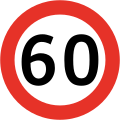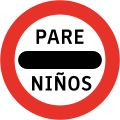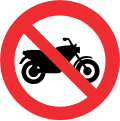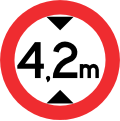Driving in Chile
As public transport is only frequent in a very few major cities like Santiago and most often poorly served in other major cities, and there is only very little of the passenger rail network, driving is a must if you want to see the Chilean beauty. Chile is one of the few countries where it is hard to get a driving licence; you need to proof that you have the national identification number and you have completed basic studies in order to obtain a Chilean driving licence.
Understand
[edit]
Similar to the United States, Chile is a car-dependent country, with most people in Chile owning cars. Public transport is only frequent in a very few major cities like Santiago and most often poorly served in other major cities, and there is only a very little portion of a passenger rail network.
The highways of Chile are the network of separate carriageways in Chile that are generally under concession and tolls, while a number of these are free and are maintained by the State, somewhat similar to the Interstate Highway System of the United States. The roads in Chile are very well maintained, even the dirt roads are regularly scraped and in good condition. Most highways are well-marked with road signs, and it is easy to navigate around the country using a map or GPS.
Highway 5 is the highway with the most concessioned sections in the country. It is the longest route with 3,364 kilometres (2,090 miles) and is part of the Pan-American Highway, and runs from Chiloé Island to Puerto Montt where it borders Peru. It continues as Peruvian Highway 1.
Carretera Austral (Highway 7) runs from Puerto Montt to Villa O'Higgins, passing through rural Patagonia, with a distance of 1,240 kilometres (770 miles).
There are also other Chilean highways like Highway 68 which runs from Santiago to Valparaíso.
There are three emergency numbers in Chile: 131 for the ambulance, 132 for fire and 133 for police. Most of the time, English proficiency tends to be poor among Chilean emergency services, so it is important that you speak in Spanish in order to tell the emergency situation.
Paperwork
[edit]Licence
[edit]If you have a tourist visa, you may drive with the driver's license from your country of origin and an International Driving Permit (IDP). You may also rent a car with an International Driver's License and purchase the necessary insurance. You must get a Chilean driver's license once you have a temporary residency.
To apply for a Chilean driving licence you must:
- be a legal driver (a legal driver is 18 and over).
- make sure that your RUN/RUT is in good standing (RUN/RUT are Chilean identification numbers).
- obtain your graduation original certificates. Government regulations can only grant driver's licenses to individuals with basic studies completed.
- apply and give three exams including written, practical and medical tests.
The most complex work, after turning 18 years old, and having the RUN/RUT, is the graduation certificates. If you are an expatriate, this is for certificates for studies completed in your home country, not Chile. If that is the case, you will need your original certificates (diplomas) recognised and certified by both your country and the Chilean consulate in your home country, before being approved in Chile.
Other documents
[edit]There are several important vehicle-related documents which you must be able to present upon demand by the police, like the permiso de circulation (proof of payment of a vehicle registration fee to the local jurisdiction in which the vehicle is regularly garaged), and proof of Chilean vehicle insurance. The rental car company will normally keep those documents somewhere in the car. For example, Avis Budget Group puts them in a portfolio folder which is small enough to fit in the glove compartment. Make sure you know where those documents are, so if you encounter the police, you will be able to present the vehicle documents promptly, along with your passport, driver's licence, IDP and rental car contract.
- Always carry proper identification, including your driver's license and passport or RUT card.
- Make sure your car has Permiso de Circulación, or vehicle registration certificate.
Car rental
[edit]Car rentals are widely available throughout most major cities, but not in smaller towns. Usually a credit card, a valid driver's licence and a passport, all three issued to the same person, are needed to rent a car. If your driver's licence is not in Spanish, you also need an International Driver Permit (IDP). Many rental car companies will not ask for an IDP, but it's a good idea to have one, just in case you encounter the police. Rental rates in Santiago are very similar to those in the U.S., but prices can be much higher in other cities. If you want to bring rental cars across South American borders (as part of a road trip), you will need to notify the rental car company in advance, pay additional fees, and obtain extra paperwork to show that you are authorized by the company to drive its vehicles across borders. Rental cars in South America all come with hidden GPS transponders (even if there is no navigation system in the car) so the company will know if you try to take the vehicle out of the country without their knowledge or drive too many kilometres per day (if your vehicle has a per-day limit).
Parking spaces and street lanes are quite narrow, so it's a good idea to get a small vehicle. However, like most Latin Americans, Chileans prefer to drive vehicles with manual transmissions to conserve fuel. As a result, the smallest vehicles available for rent with automatic transmissions are usually standard-size sedans, which are more expensive. Those who don't master manual transmissions (or don't have the paperwork) should be prepared to pay up to US$100 per day to rent such vehicles.
Rules of the road
[edit]
Driving is on the right. On expressways, keep to the right lane except for overtaking, like in Europe.
There is no right turn on red, except for signs (rarely seen) which expressly authorize right turns on red with caution after making a complete stop.
Santiago and other cities have reversible lanes and roads. They also have bus-only lanes (also used by taxis) which private vehicles are supposed to stay out of, and which are enforced by photo and video surveillance. If you enter bus-only lanes and proceed to cruise straight down several blocks, without any indication of making a turn or merging into regular lanes, don't be surprised if the rental car company informs you that you have been fined.
Like many countries, Chile prefers to use yield or give way signs whenever possible, and uses stop signs ("PARE") only when absolutely necessary (usually because it's a blind intersection and someone was killed there). If there aren't any visible traffic signs or markings governing priority, and two vehicles reach an intersection simultaneously, priority belongs to the vehicle approaching from your right.
Traffic signals are usually on timers with no sensor loops, so you will have to sit and wait even if it's the middle of the night. Unlike most Latin American countries, carjackings are relatively rare, so running red lights and stop signs late at night are not tolerated by police.
Chileans generally obey red lights, stop signs and other traffic control devices, and their driving is much more sane than most of Latin America. However, some visitors find their driving to be more aggressive than at home. This is most evident when merging, especially when traffic from multiple lanes has to merge together in order to detour around road closures or accidents. Chileans also sometimes follow the "European" model of gently bumping into other vehicles while parallel parking, in order to squeeze into very tight spaces. Thus, many Chilean vehicles have chipped or scratched paint from such close encounters.
Also, despite steep fines and frequent use of radar guns, photo radar, and speed traps, speeding is rampant. When driving on intercity expressways, you will often encounter the "autobahn" problem seen in Germany, where you might merge into the right lane behind a truck or subcompact vehicle barely able to sustain 80 km/h, then have to patiently wait for the opportunity to merge into a left lane dominated by regular vehicles driving at the speed limit of 120 km/h, as well as occasional speeders exceeding 140 km/h.
- It's mandatory to always have the car lights on, even during the day.
- It is mandatory to put on seatbelts before driving a car.
- You may not eat, smoke or have your phone while driving.
- Pedestrians always have the right of way, especially at crossings.
Signage and markings
[edit]
Chilean road signage is fairly consistent throughout the country and is an interesting hybrid of European and North American influences. The European influence is more obvious in areas like speed limit signs and graphic icons, while the North American influence is more obvious in areas like warning signs (yellow and diamond-shaped) and typefaces. They use uses both red ring and blue circle for mandatory actions (former as in the rest of Latin America and the latter as in Europe) and red ring with a red slash for prohibited actions. Most traffic signs are self-explanatory – usually icons rather than words. If you cannot read Spanish, you should check up on the most common and on the most important signs, and you might want to check Road signs in Chile on Wikipedia or a similar guide regardless.
Like European countries, but unlike most North and South American countries, Chile uses white lines on roads to divide both traffic moving in the same direction and traffic moving in opposing directions. These are supplemented with arrows on the ground as well as arrows included on street name signs.
To indicate that you cannot enter a road, Chile uses the international prohibition symbol (a red circle with a diagonal slash) over an arrow pointing directly up.
Chilean guide signs on regular highways are usually green. Guide signs on expressways (autopistas) are usually blue, except for guide signs for motorway exits, which are usually (but not always) green. Chile also uses blue squares to indicate services or a starting/ending motorway.
- Stop
- Stop and wait until children have finished crossing
- Give way
- No motorcycles
- Do not block intersection
- No entry to vehicles over 4.2 m (14 feet) high
- Turn right only
- Traffic lights ahead
- Pedestrian crossing
- Road narrows
- Winding road
Speed limits
[edit]

Speed limits are usually 50 km/h (31 mph) in cities, 100 km/h (62 mph) on intercity highways and some urban expressways, and 120 km/h (75 mph) on the finest intercity expressways. Dangerous road sections are all often signed with lower speed limits, such as hill crests, blind curves, tunnels, busy urban streets and narrow urban alleys. The latter two tend to be signed for 30 km/h (19 mph).
Speed limits are white discs with red circle as a legend, as in most of the world. The national speed limit for highways in Chile is 120 kilometres per hour (75 miles per hour), which, in this case, only applies to cars and motorcycles. Buses and trucks have a speed limit of 100 kilometres per hour (62 miles per hour), which, you should not be worrying about. Other speed limits are:
- 50 km/h (31 mph) within towns
- 60 km/h (37 mph) outside of built-up areas, and typical limit for automobiles and motorcycles
- 90 km/h (56 mph) for trucks or automobiles with trailers
Occasionally, there is a minimum speed sign in Chile, with a white rectangle with black text reading "MINIMA".
Road conditions
[edit]Chilean roads are generally good compared to most of Latin America. Expressways are virtually always well-maintained, paved, painted, signed, and largely free of potholes, cracks, litter and debris. However, many older streets in cities are in poor condition, and drivers must be alert to avoid cracks, dips, drains and potholes. Country roads are also sometimes in poor condition; they are not paved to the same thickness as in some countries, and even slight deterioration may cause the underlying dirt base to show through.
In big cities, it is a good idea to avoid rush hours, between 07:00 and 09:00 and between 17:00 and 20:00.
Carabineros and traffic stops
[edit]Traffic stops are common in Chile. Carabineros (traffic police) frequently set up roadblocks for random checks. They are not to worry about as long as you have all the documents previously mentioned and haven't been driving under the influence. You must never try to bribe the Carabineros as this would only lead to trouble! The Carabineros are unlikely to speak in any language other than their native Spanish.
Toll roads
[edit]Chile has relied upon privatized toll concessions to build and maintain major highways since the early 20th century. If you plan on driving around Chile, plan on paying lots of tolls. Rates ("tarifas") for all types of vehicles are always posted on large signs before toll plazas, and if you miss the rate sign, the current rate in effect that day for standard passenger cars is always posted on a sign in front of each separate toll booth. Chilean highways normally use barrier toll plazas at locations that are hard to avoid (e.g., near steep mountain ranges and rivers), and do not use distance-based tolling tracked through tickets.
Santiago has adopted a mandatory electronic toll collection system ("TAG") for use of all privatized tollways in the city; even the airport access road is a tollway. There are no toll plazas on the Santiago tollways, only toll gantries, so driving on them without a TAG transponder means you may incur a large fine. All rental car companies in Santiago are required to include TAG transponders in vehicles and include TAG fees in their rental car prices. Once you have rented a vehicle in Santiago, you should feel free to use Santiago tollways (which can save substantial amounts of time), since you are paying for them. Some rental companies (like Chilean) have a minimal amount (2,000 pesos) for TAG included in their rental contract. So, you do not have to worry that much about fees leaving and returning to the city. In this case, rather take a direct route than trying to avoid the toll roads.
Chile has not yet mandated full automatic interoperability between TAG and the various Televia transponders used on intercity toll roads, such as Route 68 which connects Santiago to Valparaiso. There are now programs under which users of transponders on one system can temporarily gain interoperability, but such access has to be manually requested before each use and it is a substantial hassle. And many toll plazas still do not take credit cards. Therefore, if you rent in Santiago but plan to drive to other cities, you must obtain sufficient Chilean pesos to pay tolls before leaving the city and go through the cash ("Manual") lanes at toll plazas. Similarly, if you rent in another Chilean city and drive to Santiago, you should examine city maps first and stay away from tollways that require TAG.
Parking
[edit]In 2017, Chile introduced a new law which regulates the price of parking and makes parking companies liable if your stuff is stolen.
Many private parking facilities in Chile are just like parking facilities anywhere in the world. You take a bar-coded ticket upon entry, pay at a vending machine before returning to your vehicle, and then insert the ticket into a reader at the exit gate. In Santiago, the parking concessionaire Saba uses orange RFID "ChipCoins" for the same purpose, as well as for access control to parking garages (so that the only people who can enter underground parking garages are those who already obtained ChipCoins at the vehicle entrance).
Otherwise, public parking on streets and in some surface lots is more complicated, because Chile does not have parking meters. Instead, you will see signs saying that so-and-so curb (or lot) has been reserved for a specific person or company, between certain hours, for so many pesos for every 30 minutes. If you don't see anyone present, it's usually OK to park there (unless the sign also advises otherwise), but if the concessionaire is present, they will print out a receipt on a handheld machine and tuck it under your windshield wiper to record when you arrived. You then pay them the parking fee when you come back.
In some public parking areas, even if there isn't a sign declaring that a particular street has been reserved, you may see self-appointed car guards who will demand tips in exchange for watching your car when you are absent (and who might sometimes help you back into spaces and back out of them). This is a racket (and quite annoying to people from places where car guards are not tolerated), but it's generally a good idea to cooperate; 500 pesos is usually more than sufficient to secure their cooperation, but be careful and never tell them that you will be away for a few hours, as these individuals can be associated with some shady people. Car guards are usually not seen in private parking facilities, as they have private security guards on patrol who are paid out of parking fees.
Fuel
[edit]Petrol in Chile is normally unleaded and comes in 93, 95, and 97 octane. Diesel is also available at many stations. Due to high taxes and Chile's distance from major oilfields, expect to pay about 1½ times the average U.S. price for equivalent fuel (but still less than in most of Western Europe). There are some self-service and usually you pay a little less per liter (8 pesos), but it's only available to pay by card and the machines are only in Spanish.


 Français
Français Italiano
Italiano














